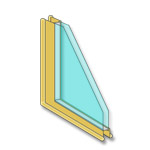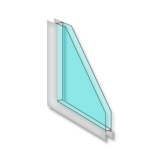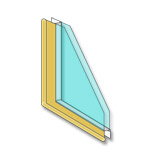Window Frame Materials
Introduction
Window frames may be manufactured in a number of materials, each of which have their advantages and disadvantages in terms of energy efficiency, durability, aesthetics and cost, as listed below;
Wooden windows

Most wooden frames will be made using timber from a sustainable forest in Scandinavia, such as European Redwood, which is then treated with preservatives to improve its durability.
More expensive hardwoods are available, usually at double the cost, but a frame’s overall durability will be influenced more by its installation and maintenance, so upgrade to a hardwood only where vital.
Wooden frames are available in a range of styles and sizes, but also different levels of finish. A basic ‘S’ model is an unfinished softwood frame, while the ‘SG’ type will be glazed too (for approximately double the price). In addition, you can order wooden frames with a stain basecoat or pre-primed or indeed fully finished with paint and furniture attached, where the delivery time will usually be longer the more ‘finished’ a window is.

- Natural look
- Can be painted or stained in any colour
- Highly flexible material that can be cut to fit any aperture
- Good thermal insulator that resists condensation
- Long lasting if well maintained

- Must be painted, stained or varnished regularly to avoid rot, warping and sticking.
- A raw timber frame is cheap but can be expensive once glazed and painted
UPVC windows

UPVC (unplasticised polyvinyl chloride), or vinyl, is now the most widely used material for home joinery as the finished windows are generally cheaper than a finished timber window.
Most widely seen in plain white, other colours are available and can also be manufactured with an embossed woodgrain, although the latter is usually 50% more expensive than the plain white option.
UPVC window frames are also usually relatively energy efficient as they include hollow chambers where air or insulation reduces heat transfer.

- Maintenance-free
- Cheapest fully finished option
- Available in a wide range of styles and sizes
- Durable
- Relatively energy efficient
- Colour permeates frame, so scratches don’t stand out

- Colour cannot be changed
- Difficult to repair
- Production and disposal produces toxic byproducts
- Dark colours fade in intense sunlight
- Not as strong as other frame materials
Aluminium windows

Introduced to the market before uPVC, aluminium can be moulded to fit any window, particularly large ones where it has the strength to support a large window pane for an uninterrupted vista. An aluminium frame adds a sharp modern look to a window.
Aluminium and its steel predecessor have, nevertheless, fallen out of favour because they conduct heat away from a room, and can become cold enough to allow condensation on the inside to frost. However, a plastic ‘thermal break’ can be placed between the interior and exterior components of the frame to overcome this problem.

- Can be painted in any colour
- Strong
- Durable

- Cause conductive heat loss unless plastic thermal breaks are included
Fibreglass windows

A recent addition to the range of options, and therefore not widely available, fibreglass is strong enough to support large window panes. Like vinyl, the frames have hollow chambers that use air or insulation to reduce heat loss, to create the most thermally insulative window frames available.

- Durable
- Strong
- Can be painted in any colour
- Can do a good impression of wood
- Colour is resistant to sunlight
- Best thermal insulation properties

- Expensive
- Still limited in available sizes
Composite windows

Composite windows are made of more than one material to combine their advantageous properties, although they are usually about double the price of a basic timber or uPVC frame.
Generally these are made of a wooden frame, to retain the attractive appearance inside, which is then clad in vinyl or aluminium on the exterior surface to improve durability and reduce the need for maintenance.
Roof windows or skylights are generally of this form.
Further information and useful links
- Types of window
- Types of glass
- Common sizes of window
- Window security
- Window requirements of the building regulations
- Full list of windows & doors topics
- Find a Window Frame supplier near you
- Find a Skylight supplier near you
- Find a Sash Window supplier near you
- Find a Glazier near you
Site Pages
Featured Articles





